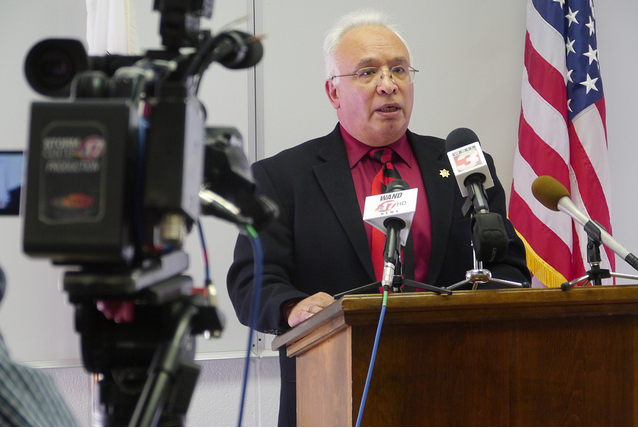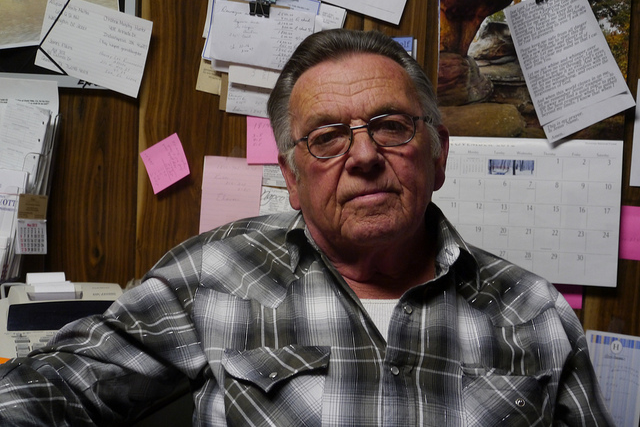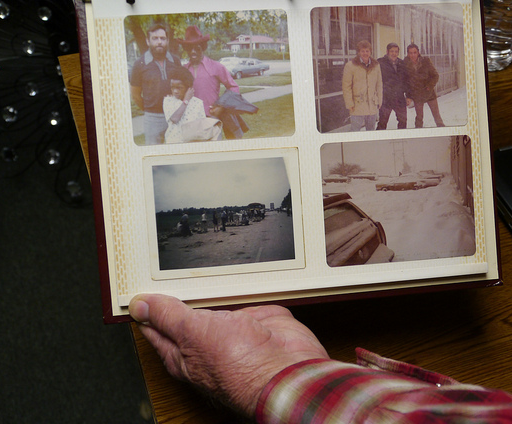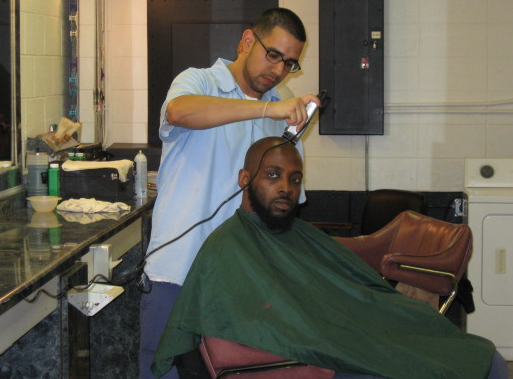Inside Vienna: The state of Illinois prisons
By Rob Wildeboer

Inside Vienna: The state of Illinois prisons
By Rob WildeboerIn his mind, Mike Whitehead can still see the play unfolding.
“Ground ball was hit to our shortstop and they had a runner on second base and she run over my shortstop. She didn’t allow my shortstop to field the ball,” said Whitehead, laughing while remembering his daughter’s Little League game from the late 1990s.
“Some things you never forget.”
The umpire who made the bad call was an inmate at the nearby Vienna prison, where Whitehead spent his 30-year career working in the kitchen.
“Everybody in this area is just used to having inmates as umpires,” Whitehead said. “As I grew up they were umpiring my games as well, so really, I mean inmates need something to do besides just sit on their duff and do nothing at all.”
That’s just one of the stories of how inmates used to be a vital part of the Vienna community, a small town about five hours straight south of Chicago and close to the Kentucky border.
Here’s another story that seems even harder to believe given the current state of Illinois’ Department of Corrections.
In 1988, Marilyn Whitnel had a pain in her chest, and she thought she was having a heart attack. She called for an ambulance, and it was inmates who came and took her to the hospital just across the state line in Paducah, Kentucky.
That’s right, prisoners provided her medical care and then took her out of the state.
“You didn’t know the difference between white or black, convict or not convict; as long as they were working on you that was all that was mattered,” Whitnel said.
At that time the prison in Vienna offered EMT classes, and inmates staffed the ambulance service in Johnson County, Illinois. That’s just how it was and people can’t recall any problems.It was just one of the connections the community had with the prison.
One more example: Whitnel’s husband Everett remembers when they had Sunday afternoon company from out town he’d often drive the visitors out to Vienna’s number one attraction.
“And you’d drive through the prison grounds, say, ‘now here’s their administration building and there’s where the prisoners live,’” Everett said. “Drive on, ‘here’s a lake that you can go fishing in,’ and once in a great while some prison official would drive up and if he didn’t know you he’d say, ‘What are you doing?’ and you’d say, ‘Well, I got company here and I just brought them out to see the prison. Oh, okay.’”
Everett Whitnel says there would be community cookouts at the prison and they would even make ice cream.
“It was very, very open,” Whitnel said. “You could drive in and out of the prison. Of course, that’s almost unheard of today, is unheard of today.”
‘Beneficial to all of us’
Indeed. This year, with little explanation or discussion, Illinois Gov. Pat Quinn has fought to keep reporters out of state prisons, including Vienna.

“I regret we didn’t represent ourselves better than we had in the past, but the fact is we’ve never changed policies,” said IDOC director Tony Godinez in a meeting with reporters who came for the prison tour. “If you present the proposal and what you want to do, we then take a look at it and I weigh in on whether or not it’s beneficial to all of us.”
Director Godinez has been with the department on and off for almost 40 years. He says having reporters in the prison is an extra strain on the department when budgets are being cut.
“We are a transparent agency and this is what this (the media tour of the Vienna prison) is about,” he said. “We are now opening up to media tours and we really didn’t do that.”
The tour
An hour before reporters showed up at Vienna, two workers were putting a fresh coat of paint on a gray light post outside the main building where reporters would enter the prison. On the tour, Warden Randy Davis took the 12 reporters and eight IDOC staffers through a living unit to show cells and a shower room. The showers on the unit were just painted the previous morning. Davis doesn’t try to hide that fact.
“Do you get ready for visitors at your house?” Davis asked. “We do the same thing. That’s what you do. You want to look good and put your best foot forward.”
Davis also says they constantly clean and paint the showers.
But moldy showers is just one of the concerns inmates complain about.
Michael Johnson has been in Vienna since August of 2011 for residential burglary. He voices the regular complaints we’ve heard from Vienna inmates — complaints that were detailed in a highly critical report by the prison watchdog John Howard Association.
Johnson talks about mice and cockroaches in the buildings, and bugs in his chili one day. He also complains about Building 19, a notoriously crowded building at Vienna.
“If you sit up here and put a hundred-something men on a dorm, and you don’t let them out all day, for weeks and months on end, incidents are going to occur, constantly, constantly,” Johnson said.
Warden Randy Davis took us through Building 19.
I’d heard about the overcrowding there and actually knew a fair bit about it from interviewing inmates and former inmates as well as reports from the John Howard Association.
But none of that prepared me for seeing it in person: Dozens and dozens of men sitting idly; lined up on rows and rows of bunks.
I simply can’t describe it. Words don’t do it justice.
I’d love to take you inside those rooms so you could see them yourself, but IDOC has so far refused to allow cameras or recording equipment inside the minimum security facility — citing simply safety and security concerns.
Reporters on the prison tour were taken to a mostly empty wing of Building 19, the men from that wing were outside in the yard except for the few who for some reason didn’t want to go out on what was an unseasonably warm and sunny day.

Men in one of the occupied wings waved at us to come in and talk with them. But prison officials said no, saying it would be a security risk.
Improvements at Vienna
Despite the conditions of Building 19, inmate Michael Johnson gives the warden credit.
“I can honestly say they are doing improvements,” Johnson said. “I don’t know who scared them but somebody put the fear of God up in ‘em, and they trying to do what they supposed to be doing to get the place together.”
Johnson says the prison has put exercise equipment and bean bag games outside the living units.
Warden Davis says they’ve also increased the amount of rec time prisoners get.
“My thing is I like to see inmates out and about and doing things,” Davis said. “It’s easier to operate. You have less problems.”
One egregious problem that former inmates mentioned were the broken windows in Building 19. The John Howard Association reported that birds could fly through the windows, which is a health concern given the problem of bird droppings in the living units.
And last year when the weather got cold the windows were boarded up. Inmates who had to spend 23 hours a day in the crowded rooms couldn’t even see outside.
Davis says in recent months they’ve rented a boom lift (one of those little carts that lifts workers 20 or 30 feet off the ground) and workers have been replacing the windows on Building 19.
Davis says the prison also replaced the vendor that was spraying for bugs after a John Howard Association report found the institution infested.
“Considering what kind of budget constraints we’re under, we think we’ve got a pretty good institution,” Davis said. “We’ve got good solid old bones but need a little cosmetic, but we’re doing pretty good.”
While Davis should be commended for addressing long-standing problems, the progress on cosmetic issues is just about meeting the most basic standards of sanitation.
But the prison still falls far short of actually helping most inmates who want to improve their job prospects for when they’re released.
Reporters on the tour saw a few dozen inmates taking classes, but hundreds and hundreds of inmates just sitting in their cells, or in the dayrooms or milling about.
That’s not how it used to be.

Harper walks to the edge of his property and points out a city park that inmates used to care for and the ditch between the park and his property.
“They would come out and mow once a week just like you would your yard,” Harper said. “They did the cleaning of this ditch and when it growed up some they’d cut it.”
When Harper worked at the prison he would help the inmates get jobs around town: picking apples, bailing hay, doing construction and they were paid minimum wage.
“And they sent part of that home and then kept part and then people had a different look as far as what inmates really was,” Harper said. “They’re human too.”
Harper says there were never any problems with inmates working in the community.
“And you take an inmate that has been out and has worked all day long” Harper said. “What does he want to do when he gets back? He wants to eat supper and when it gets bedtime he wants to go to bed because in the morning he’s got to get up and start working again.”
Harper makes his way from the lot where he sells sheds to the next property where the “This and That” flower and gift shop is run by his wife, Kathy.
It’s a small shop but customers come in and spend a half hour or more browsing and mostly chatting and laughing because everyone knows each other.
Kathy is having a big Christmas sale and everyone who comes in gets a free ceramic bear that’s a Christmas tree ornament. Some of the bears are wearing sweaters that say “#1 Grandma” and things like that. I went with the tiny dentist bear who is actually holding a tooth in a pair of pliers. What’s more festive than tooth extraction?
Inmates used to come shopping here too. Officers would bring a van load of prisoners into town and they’d go to different stores.
“They never shoplifted,” said Kathy Harper. “They were never impolite. They never took advantage or anything. They always just come in and shop like normal people and left.”

I can’t help but laugh at the fact that WBEZ spent most of this year trying to get into the prison and here was a picture with probably half the residents of Vienna at a picnic. At the prison. Back then there wasn’t even a fence around the prison — and this wasn’t the early 1900s or anything. This was just 15, 20, 25 years ago.
In those days, Harper says the prison offered college classes and Vienna residents would also enroll and go to the prison and sit in classes next to inmates.
What are we doing?
When you think about all that, the college classes, inmates shopping and working in town, working on farms making money, running the ambulances, umping baseball games, it’s hard not to get nostalgic and it’s hard not to ask the question: What exactly are we doing in corrections now?
It costs Illinois taxpayers more than a billion dollars a year. The state has 50,000 people behind bars. What is it we’re hoping to achieve? Are we achieving it?
In preparation for reporters visiting the Vienna, prison administrators were busy painting over mold in showers and replacing windows that had long been broken. They were struggling to meet basic standards of sanitation.
Dean Harper says that’s a long way from a Department of Corrections that used to try to help people put their lives back together.
“I just don’t know their system and I sometimes wonder if they know their system,” he said. “You’ve got to look back the way that it was and you can’t say that was 100 percent wrong because look at the amount of institutions that’s been built because we have incarcerated so many and not rehabilitated. So, which system works? When you take away a person’s ability to do good because they have done bad, what do you leave them?”
Harper says there doesn’t seem to be any common sense in the Department of Corrections anymore.
“If I could sit down with the governor and say, you know governor, let’s see if there’s not something that we couldn’t say, ‘Hey, corrections needs, can’t we do something with this? Can’t we go back to working the inmates, can’t we do something that’s constructive instead of being destructive?’ But you couldn’t never get them to do that. I don’t think that you could ever get them to ever sit down and admit, ‘We have a problem.’ To me it’s really a shame that we have all of these people locked up and really getting nothing in return. And it’s not that the inmate don’t want to do it. For whatever reason we won’t let them do it. It’s just that simple.”
Harper’s analysis seems spot on when I talk to inmates at Vienna.
Inmates want to work
Inmate Michael Johnson admits that as a young man prison held a certain allure for him but now that he’s a 43-year old grandfather, he can’t stand the thought of coming back.
“It’s called having another bit in you,” Johnson said. “This my fifth one. I ain’t got no more bits in me. I’m tired.”
Johnson wants a job, but given his long criminal history and his short work history he knows he needs to pick up some skills. So far that’s been impossible.

“I would love to get a welding certificate,” Johnson said. “They have a little place in Danville called Freightcar. They make trains, you know, welding is a requirement. I would be able to get down there and get a job. I just want to get in school and request slip after request slip after request slip and everything is, you’re on the waiting list, you’re on the waiting list, you’re on the waiting list.”
Advocates pushing for a return to a Department of Corrections that trains and rehabilitates inmates don’t have the numbers to make their case. The data just doesn’t exist.
A spokeswoman for the Department of Corrections explains that they didn’t track recidivism rates in any systematic way before 1989. That makes it hard to show the profitability of the old way.
“We’re running on a budget that we had six years ago with 4,000 more inmates and 3,000 less staff,” director Godinez said.
Godinez says 98 percent of his department’s budget goes to basically keeping the lights on at the institutions. Only 2 percent goes to programming for inmates.
“Given these times, we have done the best that we can with the limited resources that we have,” he said.
But Johnson is going to get out of prison, likely with no new skills. In fact, 33,000 inmates leave the Illinois prisons every year.
Johnson and other inmates say they desperately want to work when they get out.
But Johnson, like the other inmates I’ve talked to, says if he can’t find work, well, it’s pretty simple.
His children have to eat and he has to eat.